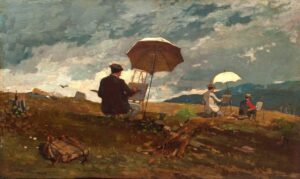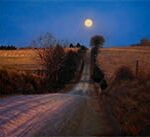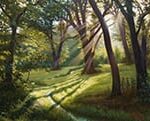Last night, as I began teaching another painting workshop, I wondered again what motivates people to put up hard earned cash and move their bodies across town (sometimes across the country) to take a painting workshop. For the most part, these are not aspiring professionals wanting to hone their skills, but folks with careers in other lines of work. I used to think that painting was just a hobby for them and a group class was a safe bet for some entertainment and relaxation. But now I’m not so sure. I have given it some thought and I believe that there is a deeper, more fundamental motivation that drives us to want to learn to paint.

by Winslow Homer
When I think about what motivates my students to be present, I now believe that it is related to that ancient need to create, apart from the other activities in their lives. There is something essential in the act of creation, or in simply learning to create, that answers this need. I can teach them all sorts of useful and necessary techniques which are helpful in the long run. But in the moment, which is all we really have, I try to keep in mind that if I fail to connect to the real reason they are present, then I probably have failed to connect with them at the most universal, fundamental level. It is love of creation that brings us together at these moments, and in that, we are all one big tribe.
John Hulsey PBS Interview
source:ninenet.org Thanks to John Hulsey for permission to use this content.
Artist John Hulsey demonstrates the art of plein aire painting as he paints the bluffs along the Missouri River. Eighth generation Floridian and environmental photojournalist Carlton Ward uses his talent to protect he natural habitat he loves. Stephanie Rond is a painter, curator, and local leader in social justice from Columbus, Ohio. The Art Car Parade of Houston, Texas.
Perception
We are currently reading two fascinating books about human development and the evolution of art: The Social Conquest of Earth by E. O. Wilson and The Age of Insight: The Quest to Understand the Unconscious in Art, Mind, and Brain, from Vienna 1900 to the Present by Eric R. Kandel. While each author offers different but mutually supportive discussions on the rise of perception, self image and cultural myth-making, they are both sharing with us different aspects of the latest scientific discoveries in the fields of human development and cognition.
Mystics have told us for centuries that what most of us experience as life is an illusion. They assert that we do not see life as it is. Rather, we impose our biased interpretations on everything that touches us and that our particular, personal vision guides our actions and reactions.
Recent research by cognitive scientists has also determined that our brains are wired to deduce general, global patterns from whatever limited, local information we can gather and then to try to form a reliable, predictive pattern or picture of the world from which we can operate. This ability to think in the abstract is a sign of higher intelligence, and is at the very root of art-making. Furthermore, we each tend to assign high value to those random events which seem to support a view or pattern which pleases us and a low value to everything else. In essence, we are seeing through personal-colored lenses.
Because the whole is too large for us to see well normally, we have evolved to operate with this illusion of certainty, each forming our own unique view of the world. Our deviations from each other’s views may be slight, or they may be great. We all accept and share certain facts about the largest phenomena in common, like gravity, the seasons, orbits of the planets, and so on. However, there are an innumerable amount of details about the world that we individually may not agree upon, that are open to interpretation. Enter the Shaman, the mystic and the artist.
So, if life is partly an illusion, what does that mean for the visual artist? Number one is good news – since everyone has a slightly different perception of the world, each artist, by definition, must create unique work. The trick is to be able to thoroughly tune in to and assign high value to one’s perceptions about the world, and then have the courage to express that unique view in one’s art.
Surprisingly, it is also ambiguity that makes great art. A certain amount of ambiguity in an image allows viewers to participate in the artist’s world-view while simultaneously imposing their own interpretations. Mr. Kandel writes, “The meaning of the image depends on each viewer’s associations and knowledge of the world and of art, and the ability to recall that knowledge and bring it to bear on the particular image.”
When looking at art, our brains are using our pattern-making architecture and our memory to extrapolate familiar, personal associations from the image, and in a sense make it part of our own experience. In this way, great art always possesses the potential to become a unique experience for each person.
Creativity





